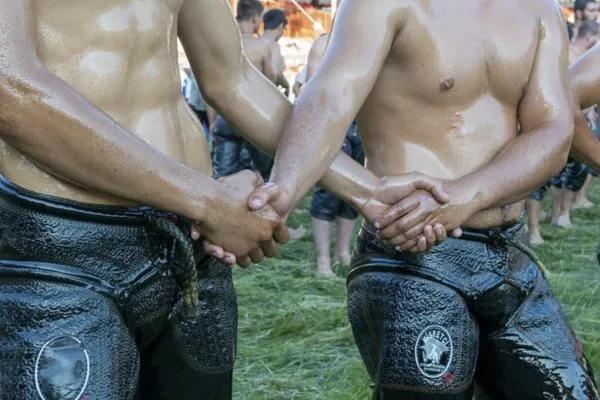Blog

Making Love
I remember my dad Jim talking to me about the first Olympic games in Melbourne in 1956 and what the impression the athletes from around the world made on the people at the time. Back then Jim worked in retail in central Melbourne and said he often saw the athletes and their entourages walking around. But he said there was one occasion that drew the collective breath of the parochial citizens in Bourke Street one day and that was the sight of two extremely large Turkish wrestlers, who dwarfed everyone around them. Though that in itself was notable the two behemoths were also holding hands as they walked down the street. I imagined that that must have initiated moral outrage in conservative Melbourne of the 1950’s. But Jim, still amazed by the recollection 50 years later, turned to me and with emphasis said, ‘nobody said anything’. Like many of Jim’s stories with their build up and immaculate timing, this made me piss myself laughing.
Like the sight of the Turkish wrestlers, people of Jim’s generation would have been horrified by the open expression of a ‘loving friendship’. Male bonding in the Australia of the 1950’s , and later, was kept safe within the boundaries of team sport where groups of men from football, cricket and tennis clubs would sally out on a Saturday to do battle and then retire to a local pub to celebrate a win or commiserate some unexpected loss (the heavy consumption of alcohol, generally beer, was unaffected by the result). This also extended to other team sports such as war. ‘Mateship’ forged during the first war in Europe and manliness and sacrifice was extolled and weakness despised as were ‘shirkers’ who didn’t volunteer for the glorious bloodletting. Weakness included acknowledging feeling or examining them. This became a baton to be passed down to the next generations. I remember being at a party as a teenager and one of the boys had a public breakup with his girlfriend and reacted by starting to sob uncontrollably. Did the rest of us support or console him? Of course we didn’t. What we did do was stand around looking uncomfortable and not knowing how to respond, apart from pretending it hadn’t changed the way we thought of him. Unfortunately it did, which meant that he was viewed with suspicion and there was bit of collective anxiety that it may happened again, even a lot of the girls we knew were too circumspect to indulge in this type of public hysteria for fear they would be labelled as emotionally unstable.
Jim told me once that European men were regarded with suspicion by his generation, mainly he said for their’ long hair’ which was emblematic of their cultural degeneracy. Clearly Turkish wrestling was also tarred with the same brush. God knows what he would have thought of the concept of loving relationships between men, I expect he would view it as another typical European vice. But loving relationships between men has a long history. In the 16th century, for example, the essayist Michel de Montaigne wrote about his loving friendship with Etienne La Boetie and how powerful it was even though was at pains to explain why it was he loved him. La Boetie’s early death at 32 yrs. meant that the friendship was never tested and that Montaigne grief may have led to a poignant idealisation of their relationship. This may also have been the case with Alfred, Lord Tennyson and Arthur Henry Hallam who met while at university. Hallam too died young of a brain haemorrhage at 22 yrs. Tennyson like Montaigne idealised their relationship but being a poet was more articulate, in a florid Victorian sense of course, and put his feelings into verse and reading it today it seems that, like Montaigne, he couldn’t quite explain what it was that created so close a bond. The poem he wrote was In Memoriam which contains the famous lines at the end of the poem:
‘Tis better to have loved and lost
Than never to have loved at all.
Jim had a friendship with a gay man when he worked in retail and I remember that they used to have a cuppa every afternoon in the cafeteria. Now I’m not saying it was a loving friendship but it shaped my views about gay men and in an era of particular intolerance, Tasmania only decriminalised homosexuality in 1997 and even then the bill was passed by only one vote, I took a benign attitude and considered it a non-issue. After this man moved interstate I asked Jim if he knew how he was going which he viewed as an invitation to go on a mini rant about how gay men were disgusting. To say I was surprised is an understatement. Jim went out of his way to beat his heterosexual chest in case I thought he had been harbouring an illicit attraction towards this man even though he got pleasure out of their friendship, they had a similar sense of humour, which lasted for years. When this man was later murdered and when Jim heard about it he brushed it off and said nothing. I was shocked by his callous indifference to the fate of this kind and gentle man. Jim was not a Michel de Montaigne or Tennyson
My poems What shall we say, The Breath, The Traction Table and We Tried traces the evolution of a physical relationship that falls short and at the end the couple realise that sweat and frisky genitals are not enough to sustain a relationship and there is a wide difference between physical relationships and loving friendships.
The issue for relationships based purely on the physical without emotional depth is that they are often driven by porn site novelty, where even choking is de rigueur FFS, and where the personal is degraded and participants objectified, so when the novelty dries up so does the relationship, and the couples retire from the field tired, sore and pale. Men and women are quite capable of having loving friendships without the distraction of sex. My experience with loving relationships is that each contact results in the application of another coating of propinquity so the relationship builds layer by layer and its predictability and stability evolves almost into a natural feature, a geographical form if you like. Trust and transparency is the hallmark of loving relationships and any element of priggishness triggered by the revelation of social transgressions should be diluted by empathy.
So for me, the question is between physical relationships and loving friendships who is ‘making love’ here? I think it’s reasonable to suggest that when you take all these elements into consideration it is the men and women in loving friendships that are actually ‘making love’ whenever they meet, connect emotionally and share their time together.
Love my words?
Stay inspired! Subscribe to my newsletter for poetry, up-coming events and creative insights
— straight to your inbox!








